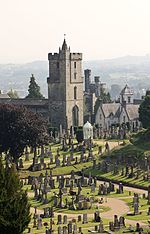Mote Hill

Mote Hill is the northern tip of the Gowanhills, Stirling, the northern half of the Royal Park that extends around Stirling Castle. The wider park includes the King's Knott and sections of a 2-metre-high deer wall, first established in the 12th century, though Gowan Hill only became park of the Royal Park around 1500. Ten thousand years ago, Mote Hill was a promontory projecting into a lost prehistoric sea. On the opposite bank of the River Forth lies Abbey Craig, upon which sits the National Wallace Monument. These two rocky outcrops were, for thousands of years, the lowest crossing point of the Forth. Mote Hill is also known as Heiding Hill or Murdoch's Knowe or Hurlie Haw and is the location of the Beheading Stone, the traditional execution block of medieval Stirling. The stone itself is now on a concrete mount and under an iron cage, but you can still see the axe marks from the executions. Mote Hill is also the site of a vitrified fort, destroyed by fire in the first half of the first millennium AD. This date was confirmed by excavation by Murray Cook, Stirling Council's archaeologist.
Excerpt from the Wikipedia article Mote Hill (License: CC BY-SA 3.0, Authors, Images).Mote Hill
Back Walk, Stirling Raploch
Geographical coordinates (GPS) Address Nearby Places Show on map
Geographical coordinates (GPS)
| Latitude | Longitude |
|---|---|
| N 56.1277 ° | E -3.9428 ° |
Address
Back Walk
Back Walk
FK8 1SH Stirling, Raploch
Scotland, United Kingdom
Open on Google Maps









